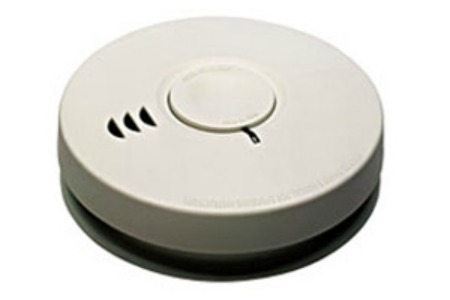
If the belching smokestack near your home worries you and you never leave the house without checking the air-quality index, here’s an eye-opener: There may be two to five times more air pollution inside your home than outside. And that’s with some of the windows open. Shut them tight during winter and contaminants get trapped, making your air quality potentially 100 times worse than that of the outside air. Here’s what top experts suggest you do to fight air pollution from the inside.
Check Your Detection Devices
Carbon monoxide and smoke detectors should be installed in a central hallway on each level of your home as well as in the basement, and a smoke detector should also be installed in each bedroom. (Check your local building codes for exact placement.) If your detectors aren’t integrated into a burglar alarm system, think about upgrading to wirelessly linked units so that if one detector gets triggered, they’ll all ring and wake up the whole family. First Alert’s OneLink Series SCO500 ($64; amazon.com), for example, provides both smoke and carbon monoxide detection, and a voice alert indicates where the alarm originated.
Test For Radon
Radon is an odorless and invisible radioactive gas that’s carcinogenic over the long term–it’s the second-leading cause of lung cancer in the United States–and has been found to be present in homes across the country. Radon gas is produced as a result of the natural breakdown of uranium in soil. The gas rises from the ground and seeps into your house through foundation cracks. Fortunately it’s easy to detect. You can buy a test kit at a hardware store for about $14, including lab fees and a postage-paid mailer. If results reveal gas levels above the EPA-recommended 4 picocuries per liter, hire a remediation company to install a system for venting the gas away from your house (about $1,200).
Service Your Heating System
Homes with heating and air-conditioning systems rely on ductwork to deliver the warmed or cooled air, and because out of sight can mean out of mind, it’s easy to forget about maintaining them. But these ducts should be cleaned every 5 to 10 years to remove dust, pet dander, pollen, and mold that can collect in the system and spread throughout the house whenever the heat kicks on, says Jeffrey May, a Tyngsborough, MA, indoor air quality inspector, an organic chemist, and the author of My House Is Killing Me! This is not a do-it-yourself job. You’ll need to hire a professional, but be savvy about which company you choose. “Pick someone who uses brushes instead of only vacuums or chemicals and cleans the blower unit–and the air-conditioner coil if you have central air,” May says. You’ll pay about $500 or more if you have central air and need the blower and coil cleaned. You should also have your heating system serviced annually to ensure that it’s burning cleanly and not causing exhaust to reenter the house as back draft.
Invisible Toxins In Your Living Room
Clear The Air
If you have forced-air heating, replacing the furnace filter four times a year will not only make your system more efficient but will go a long way toward filtering dust, mold spores, and other contaminants. But instead of using the standard flat fiberglass filters, choose pleated products (they look like accordion-folded paper) with a MERV-8 rating, and seal any gaps around the filter-access opening with duct tape. Pleated filters are more effective than fiberglass at trapping the smaller particles you’re likely to inhale. If a family member has allergies or chronic respiratory ailments, hire a contractor to upgrade your system with a media filter such as the Aprilaire Whole-House Air Cleaner, which turns the heating system into an air purifier. The project can cost around $1,000, and you’ll have to replace the $50 filter annually. Also, if you don’t have one already, add a humidifier to your furnace. “Dry winter air dehydrates the nasal and lung linings, making people more susceptible to asthma, congestion, and viral infection,” says Jay Portnoy, MD, chief of the allergy and asthma department at Children’s Mercy Hospital in Kansas City, MO.
Clean The Chimney
Every 5 years or so, you should hire a chimney sweep to clean and inspect your flues. But if your fireplace is used on a regular basis, have it done every year. A clogged flue can cause a potentially deadly exhaust backup and become a fire hazard if too much flammable soot builds up inside.
https://healthyliving.msn.com/health-wellness/keep-your-home-healthy-this-winter